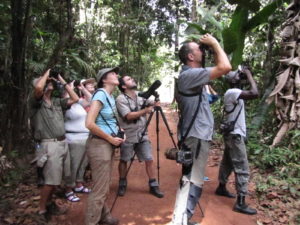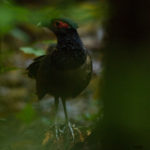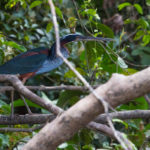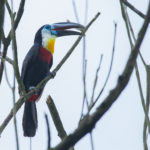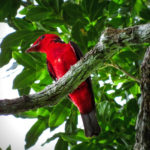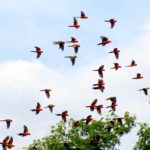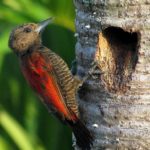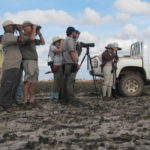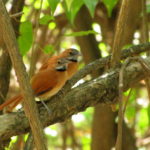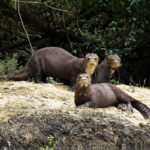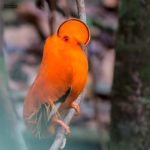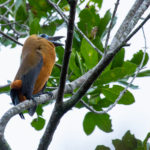Guyana rightly deserves its reputation as one of the top birding and wildlife destinations in South America. Guyana is a small English speaking South American Country resided on the Atlantic Coast east of Venezuela and west of Suriname. Our pristine habitats stretch from the protected Shell Beach and Mangrove forest along the northern coast across the vast untouched rainforest to the wide open savannah of the Rupununi in the south. Guyana hosts more than 850 different species of birds covering over 70 bird families and over 45 must see Guianan Shield endemic species that is more easy to see here than any other Country in South America.
These species range from the outrageous and stunning Guianan Cock-of-the-Rock, Harpy Eagle, Rufous-throated, White-plumed and Wing-barred Antbird, Capuchinbird, Gray-winged Trumpeter and the Rufous winged-ground Cuckoo. Blood-colored Woodpecker, Rufous Crab-Hawk, Guianan Red-Cotinga, White-winged Potoo, Black Curassow, Sun Parakeet, Red Siskin, Rio-Branco Antbird, and the Dusky Purpletuft are just some of many birding highlights that can be seen in this amazing Country.
Not only is Guyana a spectacular birding destination, it also offers tourist the opportunity to observe so many other unique flora and fauna. The elusive Jaguar that can sometimes be seen along trails, and other road-ways. Several species of monkeys including Red-howler, Black-Spider, the two Capuchins, wedge-capped and Brown Capuchin, Golden-handed tamarin, Brown-bearded Saki and Squirrel Monkey are also very often seen in their natural habitats.
In addition, there is the opportunity to see Tapirs, Capybara, Sloths, the Black Caiman, (the largest member of the alligator family and quite plentiful along the Rupununi river) and of course you can’t leave out the giant Anaconda, the elusive Puma, giant Otters, giant Anteater and even the largest fresh water scaled fish in the world, the Arapaima, also the amazing diversity of reptiles and amphibians that can enhance your birding adventure.
THE TOUR AT A GLANCE
14 nights Main Tour & 3 nights Red Siskin Extension
| Day | 1 | Arrive in Georgetown |
| Day | 2 | Georgetown and Sounding |
| Day | 3 | Georgetown to Iwokrama River Lodge Via Kaieteur Falls |
| Day | 4 | Iwokrama and Surround |
| Day | 5 | Iwokrama to Atta Rainforest Lodge |
| Day | 6 | Atta Rainforest and Surrounding |
| Day | 7 | Atta Rainforest Lodge and Surrounding |
| Day | 8 | Atta Rainforest Lodge to Surama Lodge |
| Day | 9 | Surama Lodge and Surrounding |
| Day | 10 | Surama Lodge to Caiman house |
| Day | 11 | Caiman House and Surrounding |
| Day | 12 | Caiman House to Karasabai and Manari Ranch |
| Day | 13 | Manari Surrounding & Schedule flight to Georgetown |
| Day | 14 | International Flight Back Home |
Red Siskin Extension Tour
| Day | 1 | Searching for Red Siskin, Dadanawa Ranch |
| Day | 2 | Schedule flight to Georgetown |
| Day | 3 | International Flight Back Home |
THE TOUR IN DETAILS
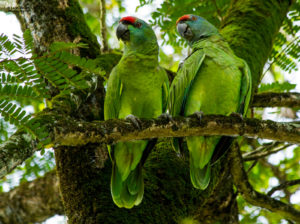
Day 1, Our tour will begin from the Cheddi Jagan International Airport. Since the tour is starting today, if you can plan your flight to land in Guyana the evening before so as to take advantage of day one early, that would be great. If for some reason you can’t arrive a day early then you can arrive early on the morning of day one and the afternoon will be used to visit the Georgetown Botanical Gardens as this would be a great introduction to the birds of Guyana. Please advise if you intend arriving the previous day.
After arriving in the vibrant city of Georgetown we will transfer to our air condition and comfortable hotel. Georgetown is located in the north of Guyana on the Atlantic coast, and about a one-third of the Country’s population lives in this English specking metropolis. The Georgetown Botanical Garden is a wonderful spot, despite their location in central Georgetown there are exclusive grounds of large tropical trees, lawns and wetland provided for some exiting birding.
Some of the species we are likely to see includes Great Black-Hawk, Snail Kite, Green-rumped Parrotlet, Great Horned Owl, and Orange-winged and, Yellow-crowned Amazons in very good numbers and Festive Parrot. White-bellied Piculet, Wing-barred Seedeater, Wattle Jacana, White-throated Toucan and a number of other amazing birds.
Overnight in Georgetown (,L,D)
Day 2, Mahaica and Abary tour: This morning we will leave our hotel
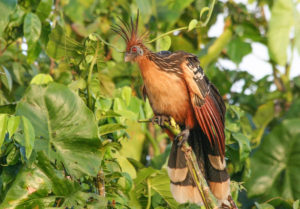
at5:00 am and head eastward along the Atlantic coast to the Mahaica River and Abary. This is where you will have a chance to see Guyana’s national bird, the “Hoatzin”. This pre-historic bird is found in abundance along these river systems with many others species including Black-collared Hawk, Black Hawk-Eagle, Barred Antshrike, Silvered Antbird, Striped Cuckoo, Mangrove Cuckoo, Little Cuckoo and a host of flycatchers and possibilities of seeing monkeys.
We will stop at Mahaica first to take advantage to view the Hoatzin as they are out on the tree tops along the river in the cooler half in the morning, after arriving at Mahaica we will meet our boat captain Mr. Naresh, use washroom if needed and then begin the tour on the river, return at Mr. Naresh for breakfast and then continue eastwards along cost to Abary.
The drive to Abary is approximately 20 to 30 minutes from Mahaica, after completing the Mahaica river tour. At this time the sun can be very hot so please keep in mind having sun screen and your bug spray as sand flies is known to be at Abary area. Abary activity will be done on foot so we will walk northeast on a 400 to 800m flat road in the direction of the seawall looking for more birds including Mangrove Cuckoo and Blood-coloured Woodpecker.
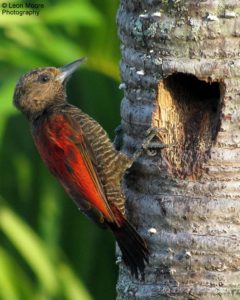
The rare and elusive Blood-coloured Woodpecker is a species most birdwatchers visiting Guyana wish to see. This woodpecker is restricted to the narrow coastal plains and is considered a Guianan Shield endemic species. Another of our targets is Rufous Crab-Hawk, White-bellied Piculet and possible small mammals including Red-rumped Agouti and Return to your hotel for Lunch.
After Lunch at your hotel we will visit the Georgetown Botanical Garden again for a chance to try and get any species we might have mist on day (1). like for example the Toco Toucan, Zone-tailed and Common Black Hawk, Cinereous Becard, and the restricted and Guianan Shield Sndemic Blood-colored Woodpecker. we will then return to our hotel for dinner.
Overnight at your Hotel in Georgetown (B,L,D)
Day 3, Georgetown to Iwokrama River Lodge via Kaieteur Falls. After an early breakfast at your hotel we will transfer to nearby Ogle airport, from here we will fly by small aircraft to Kaieteur Falls. Kaieteur Falls is the world’s longest single drop waterfall, located on the Potaro River in the Kaieteur National Park. Its location is in the Amazon forest. It is 226 meters (741 ft) high when measured from its plunge over a sandstone and conglomerate cliff to the first break. It then flows over a series of steep cascades that, when included in the measurements, bring the total height to 251 meters (822 ft). While many falls have greater height, few have the combination of height and water volume, and Kaieteur is among the most powerful waterfalls in the world with an- average flow rate of 663 cubic meters per second (23,400 cubic feet per second). Kaieteur Falls is five times higher than the Niagara Falls and about twice the height of the Victoria Falls.
Kaieteur Falls is more impressive for its remoteness and it is altogether
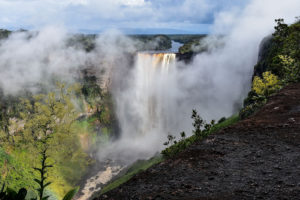
possible that we’ll be the only persons viewing it at the time. Here we will use the opportunity to look for White-chinned Swift and White-tipped Swift swarming over the gorge or perhaps the brilliant and colorful Guianan Cock-of-the-Rock at a small lek and another of our target, Orange-breasted Falcon souring over the gorge as it hunts for Swifts. Some other species we might find includes Roraiman Antbird, Musician Wren, Cliff Flycatcher and Red-shoulder Tanager and even the Golden Poison Frog that lives in the forest at the falls. After our time at the falls, our flight continues to the Amerindian village of Fairview where we will board our 4x4s or Bedford truck and take a 10 minutes transfer to Iwokrama River Lodge.
The Iwokrama Rainforest is a vast wilderness of one million acres. This protected area was established in 1996 as the Iwokrama International Centre for Rainforest Conservation and Development. The Iwokrama Forest is in the heart of one of four last untouched tropical forests of the world – The Guiana Shield of North-Eastern South America. Iwokrama was established as a living laboratory for tropical forest management because the unsustainable utilization of these forests will result in the extinction of half the world’s plant and animal species and unknown changes to global climate. This is a protected area with a difference – the full involvement of people. Iwokrama is exceptional among conservation organizations because it joins with local people in every aspect of its work. From research to business, Iwokrama ensures local economic and social benefits from forest use and conservation. The Forest is in the homeland of the Makushi people, who have lived here and used the forest for thousands of years. People are a vertical part of the ecosystem. The success of Iwokrama relies on the ownership of local people and the combined skills of specialists and communities. Iwokrama does what so many International conventions have acknowledged as best practice. It has begun conservation locally and integrated conservation into national development.
On arrival at the river lodge you will received a welcome by the staff and then settle into your room. The afternoon will be free to venture into the forest for an interruptive walk looking at the different frees, flowers and orchids, there is also a Capuchinbird lek along one of the trails which we will be visiting, you may also have chances to see Monkeys including Red Howler, Black Spider, and Guianan Saki Monkey, return to the lodge at sunset. After dinner we will venture out on the Essequibo by boat in the dark with expert boat captain looking for night animals including tree Boas, Black Caiman, Ladder-tailed nightjars, and if the water is low enough, along the sandbanks you may have chance to see some freshwater stingrays.
Overnight at Iwokrama River Lodge (B,L,D)
Day 4, Iwokrama River Lodge and Surrounding: We will start the day
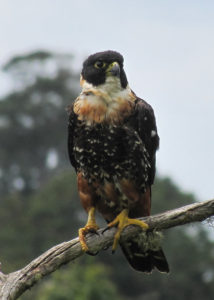
very early after breakfast; a trip to Iwokrama is not complete without a hike to the top of Turtle Mountain. Take a boat journey downriver river approximately 30 minutes and then hike for about 1 and ½ hour slow walk up the well forested trail up to 300 meter (950ft) summit for a stunning jungle vista punctuated by the powerful Essequibo River snaking through the forest. Numerous bird species can be spotted on the lower trail including the Red-and-Black Grosbeak, Yellow-billed Jacamar, and Brown-bellied Antwren. On the way up we will also have chances to learn and study the amazing plant-life along the trail, once we’re on top we will look for the very uncommon and unique Orange-breasted Falcon also you may have chances to see Scarlet and Red-and-green Macaws flying at eye level or looking down as they fly above the rainforest.
In the late afternoon depending on the time, you will have the chance to explore the forest trails around the lodge looking for Rose-breasted Chat, Wing-banded Antbird, White-plumed Antbird, Rufous-throated Antbird, Brown-bellied and Rufous-bellied Antwren, Chestnut-rumped, Red-billed, Amazonian-barred, Buff-throated and Wedge-billed Woodcreeper. Also among forest flocks are Lineated Woodcreeper, Yellow-throated and Waved Woodpecker and finally before returning to the Lodge another chance at the Capuchinbird lek as well as Spotted Antpitta among many others birds species.
Overnight at Iwokrama Rive Lodge (B,L,D)
Day 5, Transfer from Iwokrama to Atta Lodge and Canopy Walkway: After an early breakfast we will transfer to Atta Lodge and Canopy
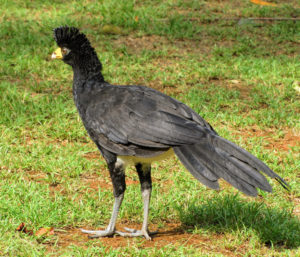
Walkway via Mori Scrub. Mori Scrub is a unique white sand forest about 40 minutes from the river lodge that host some key bird species that would be nice to add to your bird list. This area is very flat so the hike would be very easy. Among the species seen here includes Red-legged Tinamou, Red-shoulder Tanager, Bronzy Jacamar, Rufous-crowned Elaenia, Black Manakin, Guianan Schiffornis and a number of other amazing species. Along the way you might want to have your cameras and binoculars ready as other birds can be seen while driving through the rainforest also Jaguars and other mammals can be seen as well, no promise but many have been lucky! We then continue to Atta Lodge; upon arrival we will receive a welcome by the staff before settling into our accommodation. Our simple but comfortable lodge is located within the Iwokrama one million acres of protected rainforest, after settling in, at dusk we will take an afternoon walk on the walkway.
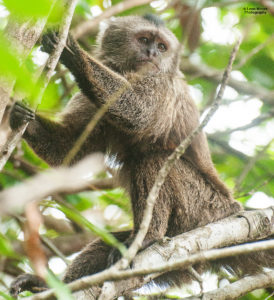
The Lodge is situated approximately 750 meters from the Iwokrama Canopy Walkway. The walkway has three platforms, the highest of which is over 30 meters above the ground, and these will allow us to get great looks at a range of canopy species. Among the likely highlights are Painted, and Golden-winged Parakeets, Caica Parrot, Guianan Puffbird, Waved and Golden-collared Woodpeckers and Spot-tailed, Todd’s and Ash-winged Antwrens. The walkway is also an excellent place to look for various species of cotinga including the Dusky Purpletuft and if there are any suitable fruiting trees nearby, we stand a good chance of seeing this bird, as well as Purple-breasted Cotinga.
Another area where we will want to spend some time is the clearing around the lodge, as this is one of the best places to see the Crimson Fruitcrow. This species is seen here on a reasonably regular basis, as it often comes to feed in some of the nearby trees.
The clearing is also a site for Black Curassow as there is a family party that comes out to feed on the forest edge. With reasonable luck, we should be able to add this bird to the impressive list of species we hope to see around the lodge and walkway.
Overnight at Atta Lodge (B,L,D)
Day 6 , Atta Rainforest Lodge and Surrounding: This morning we will

head out to the Walkway at first light to have possible opportunities looking for canopy species including Todd’s Antwren, Spot-tailed Antwren, Short-tailed Pygmy-Tyrants, Guianan Toucanet, Green Aracari, Painted Parakeet, Screaming Piha, Black-headed Parrot, Guianan Puffbird, Dusky Purpletuft, Great Jacamar, Paradise Tanager, Blue-backed Tanager, Golden-sided Euphonia, Purple and Green Honeycreeper, Black-faced Dacnis, Long-billed Gnatwren, Buff-cheeked Greenlet, Tiny-tyrant Manakin and Black Nunbird. This entire morning will involve birding on the canopy walkway and the trails around the lodge.
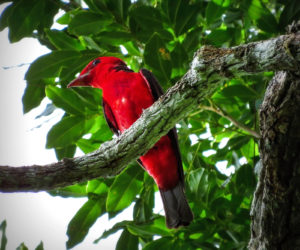
Within the forest that surrounds the lodge we can look for Great and Variegated Tinamous, Spotted Antpitta, Red-and-Black Grosbeak Grey-winged Trumpeter, Cayenne Jay, Amazonian Barred Woodcreeper, Red-billed Woodcreeper, Helmeted Pygmy-Tyrant, Painted Tody-Flycatcher, Ferruginous-backed Antbird, Guianan Warbling Antbird, White-crested Spadebill, Waved, Chestnut and Red-necked Woodpeckers as well as Black Spider Monkey and White-faced Saki Monkey.
After lunch, we will spend the afternoon birding on the main road through the Iwokrama Forest. Blue-backed Tanager, Black-chinned, Scale-backed and Grey Antbird, Guianan Streaked Antwren, Amazonian and Mouse-coloured Antshrike, Reddish Hermit, Tiny Tyrant Manakin, Rose-breasted Chat, Black and Red-throated Caracaras, Guianan Trogon, Golden-winged Parakeet and Yellow-green Grosbeaks.
While birding along the road, we will also keep our eyes open for the elusive Jaguar and Tapir which are often seen at dawn and dusk. On our way back to Atta Lodge, we will use torchlight or spotlight to do some night birding, mainly looking for owls and Potoo; This is a great place to look for Potoo but it must be stressed these birds can be very hard to find. Nevertheless, there are possibilities for White-winged Potoo, Great Potoo, Common Potoo and Long-tailed Potoo, plus Northern Tawny-bellied Screech-Owl, Spectacled, Black-banded, Amazonian Pygmy-Owl and Crested Owl.
Overnight at Atta Rainforest Lodge (B,L,D)
Day 7, Atta Rainforest Lodge and Surrounding: Today we will continue birding along several forest trails, the main roan and possibly the Walkway.
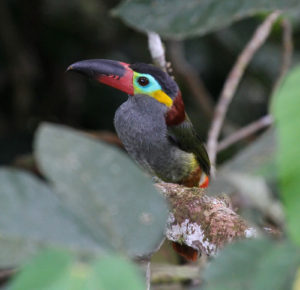
At dawn we will rise early and begin our day spending some time around the clearing before taking the trails at the lodge, we will be mainly looking for our targets including Crimson Fruitcrow, Guianan Toucanet, Painted Tody-Flycatcher, Blue-backed Tanager, Golden-sided and Plumbeous Euphonia. We will then continue birding the trails looking for Red-and-Black Grosbeak, Royal Flycatcher, Spotted Antpitta, Gray-winged Trumpeter, Tiny Tyrant-Manakin, White-throated Manakin, Red-billed, Chestnut-Rumped and Amazonian-barred Woodpecker.
Among forest flocks includes Rufous and Brown-bellied Antwren, Dusky-throated and Cinereous Antshrike, Long-winged, Gray and white-flanked Antwren, Olivaceous Flatbill, Whiskered Flycatcher and Tawny-crowned Greenlet. The Walkway will be a good spot to look for some high canopy specialist includes Buff-cheeked Greenlet, Lineated Woodcreeper, Todd’s and Spot-tailed Antwren and Guianan Puffbird. While on the walkway we will keep our eyes out for Blue-Cheeked, and Red-fan Parrot, Guianan Trogon, Painted Parakeet and the high flying and most times hard to see, Lilac-tailed and Sapphire-rumped Parrotlet and once trees are blooming we should see Fiery-tailed Awbill, Rufous-throated Sapphire, Fork-tailed Woodnymph, and possibly Crimson Topaz.
After breakfast we will spend some more time around the clearing looking for Crimson Fruitcrow, Green Aracari, Blue-backed Tanager, Guianan and Olive-green Tyrannulet and most times in the forest at the lodge, Guianan-red Cotinga and Red-billed Woodpecker. We will then head back in the trails looking for Black-throated Antshrike, Ferruginous-backed Antbird, the very hard to find Rufous-winged ground-Cuckoo and keep a very close eye out for Black-face Hawk. After Lunch the entire afternoon will be spent looking for birds that we might have missed during the morning and eventually venture out and along the main road at a spot where the Crimson Topaz now holds as a favorite area. Return for Dinner.
Overnight at Atta Rainforest Lodge (B,L,D)
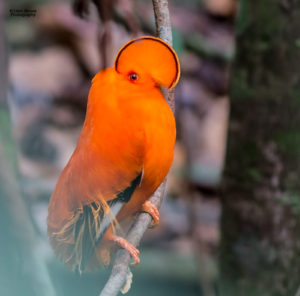
Day 8, Atta Rainforest Lodge to Surama Lodge via Cock of the Rock Lek: Today we will rise before dawn, have some coffee then take our final morning at Atta Lodge birding the clearing around the Lodge looking to nailed a few more of targets species that we might have missed including Green Aracari, Guianan Toucanet, Guianan Trogon, Painted tody-Flycatcher, Guianan Tyrannulet and more before breakfast and venture to Surama Lodge. Our 4x4s or Bedford Truck will take us through the rainforest to the Cock-of-the-Rock lek, this location is about 20 minutes flat walk on a forest trail, we should have a good chance to see and photograph this unique bird. Along this trail other birds have been seen before including Rufous Winged-ground Cuckoo, Spotted Antpitta, Amazonian Motmot, Scarlet and Red- and-green Macaw, Painted Parakeets, White-plumed and Rufous-throated Antbird and more. We then continue to the Amerindian village of Surama and Lodge, here you will be welcome by the Staff and then settle into your very simple and basic accommodation for the next 2 nights. The Amerindian community of Surama is located in the heart of Guyana.
The village is set in five square miles of savannah which is ringed by the forest covered Pakarima Mountains. Surama’s inhabitants are mainly made up of the Makushi people one of the nine indigenous people of Guyana. They still observe many of the traditional practices of their forebears.After Lunch as the afternoon cools you have a few options, take a tour of the village or venture out into the savanna and through the forest for a chance to observed birds including White-naped Xenopsaris, Fiery-tailed Awlbill, Tufted Coquette and more. We may also visit a nearby pond to look for the Great Potoo that roost in the area. Return to the lodge for dinner.
Overnight at Surama Lodge (BLD)
Day 9, Surama and Surrounding: This morning you will rise before dawn
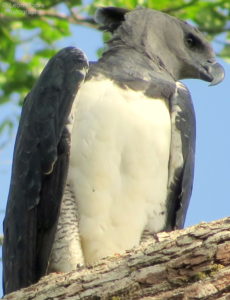
and drive out by 4×4 through the forest with pack breakfast to a nearby trail, here you will take a flat hike for about an hour each way to look for the Harpy Eagle.
This area is where the Harpy Eagle nest approximately every 3 years. When these amazing birds have a new chick the cycle from chick to when it takes first flight is about 6 to 10 months but still depend on the adults to provide food while staying in the area of the forest, this may go on for another year or more. The Harpy Eagle stands about 3 feet and has a vast 6 feet wingspan and is the largest bird of prey in the world so this amazing bird will be a great bird to add to your list.
Along this trail you may have possibilities of seeing monkeys and other wonderful birds including the White-crested Spadebill, Brown-bellied Antwren, Rufous-bellied Antwren, Black-throated Antshrike, Capuchinbird and also learn more about the forest there. After that, return to Surama for lunch.
As the afternoon cools, you then take a walk or transfer across the savannah and through the rain forest to the Burro-Burro River. Your guides will then paddle you on the Burro- Burro River for possible opportunities to observe Giant River Otters, Tapir, Tayra, Spider Monkey and many other species of birds that we will be targeting including Ocellated Crake, Lesser Nighthawk, Chapman’s Swift, Spotted Antpitta, Gray-winged Trumpeter, Tiny Tyrant-Manakin, White-throated Manakin, Red-billed, Chestnut-Rumped and Amazonian-barred Woodpecker and also the very elusive Rufous Winged-ground Cuckoo, we found an area where this rare bird have been seen on several trips before so we will try to add this bird to your list as well. Return to village for sunset or return in the dark before dinner with flashlights looking for mainly Owls, Potoos and other night animals.
Overnight at Surama Lodge (B,L,D)
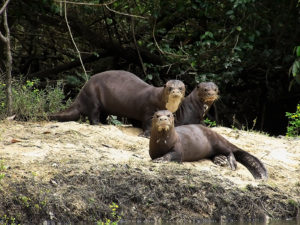
Day 10 : Transfer to Caiman House; this morning after an early breakfast we will transfer to Caiman House, along the way we will check a few forest edge and many savannah pounds to see if we can locate the highly elusive Zigzag Heron. Grey-necked wood-Rail, Cocoi Heron, Maguire Stork, Buff-necked Ibis, the stunning Jabiru Storks, Savanna, Great Black and Zone-tailed Hawk. The journey ends at Caiman House where we will be welcome by the staff, settle into our accommodation then have lunch.
Caiman House Field Station was built in Yupukari by an American family who moved to the area so Peter Taylor could conduct a field study on black caiman (Melanosuchus niger), the largest member of the alligator family and a species that is listed by CITES as endangered, Black caiman are severely depleted in nearly all their former range, but are found in abundance in the waters of the Rupununi River. The field study is an attempt to gain an understanding of the black caiman’s ecological role, as well as its context within local communities.
By basing the study in a local village, and using local residents as assistants, it will hopefully instil a better understanding of the caiman’s importance in the local ecosystem. It is also hoped that a healthy population could lead to a sustainable resource, possibly through ecotourism.

Guests are invited to join the caiman research crew in a night of caiman capturing. It’s a bit like having a job with a National Geographic crew. In the afternoon we will take a leisurely boat trip on the river beside our lodge. Here we are likely to find kingfishers including both Green-and-Rufous and American Pygmy, the superb Agami Heron, Capped Heron, Sungrebe, Sunbittern, Pied Lapwings, Boat-billed Herons, Large-billed Tern, Black Skimmer, Pale-legged Hornero, Bare-necked Fruitcrow, Spotted Puffbird and with luck we may come across the secretive Crestless Curassow. In addition, we may see Black and Spectacled Caiman, Giant River Otter, Capybara and many species of monkeys and even the occasional Arapaima or River Stingray. As the sun set we may see Band-tailed Nightjars and possibly Nacunda Nighthawk and Common Potoo.
Overnight at Caiman House (B,L,D)
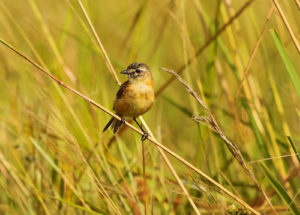
Day 11 : Caiman House and sounding: This morning after breakfast we will have a chance to do some birding in the open Savanna and forest patches where many species including Blue-backed Manakin, Pale-tipped Tyrannulet, White-bellied Antbird, Pale-eyed Pygmy-Tyrant, Finch’s Euphonia, Ochre-lored Flatbill and even Tropical Screech-Owl, we will then set off into the Savanna in our 4×4’s in search of several seldom seen birds mainly the Crested Doradito and Bearded Tachuri, both of which like to keep low down in short grasses close to water. The rare and localized Crested Doradito was only recently discovered here and we have a very good chance of finding it. Other species on our morning hike include Sharp-tailed Ibis, Yellowish Pipit, Pinnated Bittern, White-tailed Goldenthroat, Double-striped Thick-knee, Ferruginous Pygmy-Owl and Maguari Stork. This is also our best chance to see the breathtaking Giant Anteater in habitat surrounding this area.
Overnight Caiman House B,L,D
Day 12, , Caiman House to Karasabai. This morning after breakfast we
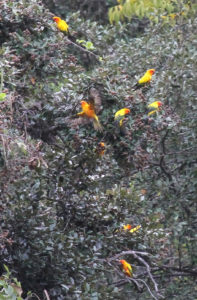
will continue on our journey to Karasabai on rough road passing through very nice habitats such as open savanna and the Pakarima mountain range with gallery forest patches, here Aplomado Falcon hunts over expansive plains with Grassland Yellow-Finches mix with a variety of seedeaters, including Gray, Plumbeous, Chestnut, Ruddy and Lined Seedeaters. We also stand good chances of encountering Giant Anteaters as they pass through the savanna, we will be passing lots of ponds so these spots should produce very good birding opportunities, Herons, Egrets and Storks should be expected along with Savanna and White-tailed Hawk, Lesser Yellow-headed and King Vulture and many other great birds on the drive to this very remote village of Karasabai with its exceptionally friendly resident.
Upon arrival we will take time to visit some of the locals in order to secure final permission to bird the area. The reason for doing this is because they are very few visitors here and we wish to ensure the good relation and ongoing conservation efforts, especially when considering that these people ultimately controls the fate of the Sun Parakeet.
This riparian forest along the border of Brazil where we will be birding during the morning offers some very interesting birding opportunities. Our targeted bird will be the Sun Parakeet but other birds including Red-and-Green- Macaw, Green-rumped Parrotlet, Black-and-White Hawk-Eagle, Zone-tailed Hawk, Rufous-browed Pepper shrike, Ferruginous Pygmy-Owl and many other wonderful birds.
We will be visiting nearby forest through some local farm lands in search of the special bird, the Sun Parakeet. Return to the village for lunch. After lunch we will continue our way back birding to Manari Ranch that is located just 15 minutes outside the town of Lethem near the Brazilian border for dinner. Upon arrival we will be welcome by our local guide and staff who will be taking us to look for the very rare Rio Branco Antbird and the Hoarey-throated Spinetail the next morning. Settle into our very simple but comfortable accommodation for the next two nights.
Overnight at Manari Ranch B,L,D .
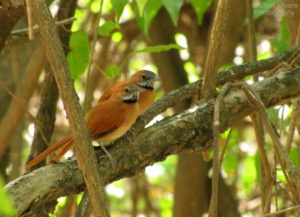
Day 13, Manari Ranch Surrounding and scheduled flight to Georgetown: Today well focus our attention on two birds with exceedingly restricted ranges, the Hoary-throated Spinetail and the Rio Branco Antbird. Both species are only found in gallery forest along the Rio Branco River and other main tributaries, all of which ultimately flow into the Amazon. Recent agricultural pressures have seriously reduced the amount of available habitat for these birds, and as a result the Spinetail is now classified as endangered, with the Antbird treated as near-threaten. In order to reach suitable habitat for these we will travel by 4×4 through the open Savannah.
Along the way we might come access Maguari, Jabiru Storks, Black-Collared Hawk, Ring Kingfishers, and Rufous-tailed Jacamar, Black-chinned Antbird, Orange-backed Troupial and other species before reaching our site along a comparatively short stretch near the Iring River. We will specifically target the Hoary-throated Spinetail and the Bio Branco Antbird in this area, although other interesting species may include Pale-legged Hornero, Double-striped Thick-knee, Golden-spangle Piculet, and Ferruginous Pygmy-Owl, Flavescent Warbler and more.
After Lunch; for those not participating in the Red Siskin extension tour will be transfer to Lethem Airstrip where you will board your schedule flight back to Georgetown. You will spend your final night in Guyana and celebrate your journey and experience of this beautiful Country.
Overnight in Georgetown (B,L,D)
Day 14 , Final departure for those not participating in the Red Siskin extension . This morning we will transfer to the airport to connect with your international flight back home.
For those participating in the Red Siskin extension, our afternoon continues with birding in the Savanna around Manari Ranch. We will be visiting nearby ponds and forest patches in the area. Mainly looking for birds we might have mist in the Savanna and work more on getting better looks at some of the species we saw before and if possible take photos of them. Some of the species seen around includes White-tailed, Savanna, and Zone-tailed Hawk. Crested Bobwhite, Spot-breasted Woodpecker, Plain-breasted ground-Dove, Jabiru and, Maguari Stork, White-tailed Kite, Burrowing Owl, Grassland Yellow-Finch, Wedge-tailed Grass-Finch, Yellow-crowned Parrot, Eastern Meadowlark, Lineated Woodpecker, Finsch’s Euphonia and many other birds that can be found in the area surrounding Manari Ranch.
Red Siskin Extension Birding Tour

Day 1, Manari Ranch to Dadanawa Ranch: Today we have an extremely early start in search of the highly endangered Red Siskin South of Lethem. This requires traveling for several hours to Dadanawa Ranch. Upon arrival we will have breakfast before heading out in search of this unique bird. A fairly large population of Red Siskin was discovered in this region in 2003, far removed from any previously known colony, and we stand a good chance of observing this strikingly plumage species with an estimate world population of 600-6000 pairs. Our main objective will be to focus on locating the Siskin as this activity is just for one day at this stage of the tour and also due to the very long distance we have to cover in getting to and from the area, the sooner we can find them the better.
While our main focus will be on the Red Siskin they are other birds that we might come across including, Pale-bellied Tyrant- Manakin, White-barred Piculet, Bicolored Hawk, Savanna Hawk, and White-tailed Hawk, Zone-tailed Hawk, Flavescent Warbler, Ferruginous Pygmy-Owl, White-bellied Antbird, White-fringed Antwren, Crested Bobwhite and many more. We will return to Dadanawa Ranch for Lunch and then head back to our main Ranch for Dinner.
Overnight at Manari Ranch (BLD)
Day 2, Lethem to Georgetown: This is our final morning at Manari Ranch. Today we will take the opportunity to do some birding around the Ranch and also take pictures of some of the species seen around including the stunning Orange-backed Troupial, Crested Bobwhite, Savanna Hawk, Glittering-throated Emerald, Spotted-breasted woodpecker and many other great birds seen here. After breakfast we will transfer to Lethem to connect with our scheduled flight to Georgetown. We will spend out final night in Georgetown and celebrate our journey and experience of this amazing Country.
Overnight in Georgetown (B,L,D)
Day 3, Our final departure. This morning we will transfer to the airport to connect with your international flight back home.
CALL FOR PRICE
Price per person based on double occupancy
Single supplement US$350
14 nights main tour & 3 nights Red Siskin tour extension
Minimum 4 guests to operate, maximum size: 10 guests
YOUR GUIDES

SOME TARGET SPECIES
- Red-billed Woodcreeper
- Rufous winged-ground Cuckoo
- Orange-breasted Falcon
- Crimson Fruitcrow
- White-winged Potoo
- Guianan-Cock-of-the-Rock
- Blood-Colored Woodpecker
- Rufous Crab-Hawk
- Hoatzin
- Harpy Eagle
- Spotted Antpitta
- White-plumbed Antbird
- Rufous-throated Antbird
- Gray-winged Trumpeter
- Guianan Tyrannulet
- Guianan-red Cotinga
- Guianan-warbling Antbird
- Rufous-crowned Elaenia
- Black Curassow
- Green Aracari
- Blue-cheeked Parakeet
- Guianan Puffbird
- Guianan Trogon
- Spot-tailed Antwren
- Todd’s Antwren
- Dusky Purpletuft
- Brown-bellied Antwren
- Pompadour Cotinga
- Guianan Woodcreeper
- Yellow-throated Woodpecker
- Sun Parakeet
- Red Siskin
- Hoary-throated Spinetail
- Rio-branco Antbird
- Blue-cheeked Parrot
- Black Manakin
TOUR FACTS
INTERNATIONAL FLIGHTS
The cost of this tour does not include the price of your international flight to and from Guyana. You are responsible for arranging these flights to and from Georgetown. I recommend that you arrive a day early to rest and adjust to the time zone before our early morning departure on day two.
TRIP INSURANCE
The purchase of trip cancellation insurance is strongly recommended. Leon Moore Nature Experience (LMNE) cannot accept liability for airline cancellations or delays or penalties incurred by the purchase of non-refundable airline tickets or other expenses incurred by tour participants in preparing for this tour.
IMPORTANT:
Rates are subject to change due to currency fluctuation.
On domestic Schedule flights within Guyana, passengers are allowed a total of 20Lbs or 9kg of luggage on Aircraft; if one is over the limit, he or she is charge 74 cents or 140 Guyana dollars for every pound over weight. It is important that clients must provide his or her body and luggage weight in advance so this can be provided to the domestic airline in Guyana.
Because most of our clients comes from either north America or the UK; we know that clients would sometimes have to travel with weather clothing/extra jacket for cold weather; these and any other clothing or items he or she wish to leave in within our storage, arrangements can be made to facilitate this.
Tipping: The cost does not include any tips however it is totally up to you, if you feel that an individual/staff preformed excellent and you wish to leave a tip please do. If you feel that your tour leader provided you with excellent service, you are free to tip him as well.
- Please Note: Guyana is generally hot and humid. On most morning we will be up and out very early to take advantage of the cooler temperature and wildlife activity.
- This tour does not require a high level of fitness but participants should be in good general health as some of the birding will be done on foot and may require walking for several hours at times but at (slow pace). Should you have any physical limitation please let us know in advance before you leave your destination.
- Accommodation is generally simple but comfortable, throughout they are no air-condition at the interior lodges but cool at nights, that’s Guyana temperature!
- Some interior local roads can be bumpy at times based on conduction.
- The Vehicle we used are generally 4×4 and sometime open tops so at times we can be either sitting or standing to get a better view of possible wildlife or the forest.
- A part from your hotel in Georgetown, none of the interior Lodges have hot shower.
- None of the Interior Lodges accept Credit cards, on arrival you can change and get money from or Bank etc..
- Mosquito nets are provided throughout the lodges, you can expect some biting insect like mosquitos, sandflies, (noseeams).
- The risk of catching Malaria is low.
- Electricity is available at all the lodges, Generator or Solar power. Although the lodges is 110V and the outlets/plugs are USA type.


